True or False:
Anatomy is the study of body structures and their relationships.
True
True or False:
Physiology is the science of how body parts function.
True
Name the 3 major subdivision of anatomy.
- gross anatomy
- microscopic anoatomy
- developmental anatomy
Physiology concerns the ________________ of specific organs organ systems.
functioning
What 2 principles explain Physiology?
- Chemical Principle
- Physical Principle
The ______________ principle explains the reasoning why anatomy and physiology are inseparable.
- complementary of structure and function
Anatomy and physiology are inseparable: What a body can do depends on the unique architecture of its parts.
Name the levels of structural organization of the body, from simplest to the most complex.
- chemical
- cellular
- tissue
- organ
- organ system
- organism
Name the 11 organ systems of the body.
- integumentary, skeletal, muscular, nervous, endocrine, cardiovascular, lymphatic, respiratory, digestive, urinary, and reproductive.
The immune system is a functional system closely associated with the lymphatic system.
Name the 7 vital functional activities necessary of life.
- maintenance of boundaries
- movement
- responsiveness, digestion
- metabolism
- excretion
- reproduction
- growth
Name the 5 survival needs necessary for life.
- nutrients
- water
- oxygen
- appropriate temperature
- atmospheric pressue
True or False:
Homeostasis is NOT a dynamic equilibrium of the internal environment.
False
- Homeostasis is a dynamic equilibrium of the internal environment. All body systems contribute ot homeostasis, by the nervous and endocrine systems are most important. Homeostasis is necessary for health.
Name the 3 control mechanisms of the body that work together during homeostasis.
- receptor(s)
- control center
- effector(s)
__________ __________ _________ reduce the effect of the original stimulus, and are essential for maintaining homeostatic control
- Negative feedback mechanisms
Body temperature, heart rate, breathing rate and depth, and blood levels of glucose and certain irons are regulated by negative feedback mechanisms.
_________ ____________ __________ intensify the initial stimulus, leading to an enhancement of the response during homeostatic control.
- Positive feedback mechanisums
Positive feedback mechanisms rarely contribute to homeostasis, but blood clotting and labor contraction are regulated by such mechanisms.
True or False:
With age, efficiency of negative feedback mechanisms declines. These change underlie certain disease conditions.
True
What position is represented by: the body erect, facing forward, feet slightly apart, arms at sides with palms facing forward
- Anatomical position
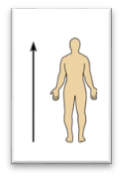
Name the Orientation and directional term.
- Superior (cranial)
toward the head end or upper part of thea structure or the body; above - head is superior to the abdomen.
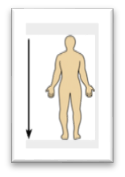
Name the Orientation and directional term.
- Inferior (caudal)
Away from the head end or oward the lower part of a structur or the body, below - the navel is inferior o the chin.
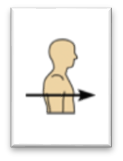
Name the Orientation and directional term.
- Anterior (ventral)
Toward or at the front of the body; in front of - the breastbone is anterior to the spine.
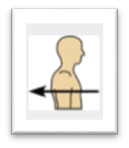
Name the Orientation and directional term.
- Posterior (dorsal)
Toward or at the back of the body; behind - the heart is posterior to the breastbone.
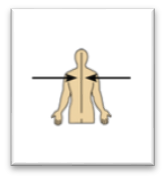
Name the Orientation and directional term.
- Medial
Toward or at the midline of the body; on the inner side of - the heart is medial to the arm.
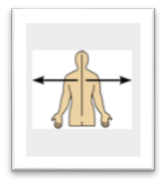
Name the Orientation and directional term.
- Lateral
Away from the mid-line of the body; on the outer side of - the arms are lateral to the chest.
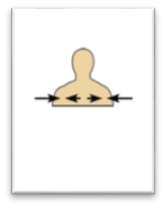
Name the Orientation and directional term.
- Intermediate
Between a more medial and a more lateral structure - the collarbone is intermediate between the breastbone and the shoulder.
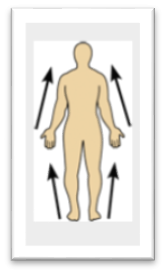
Name the Orientation and directional term.
- Proximal
Closer to the origin of the body part or attachment of a limb to th ebody ttrunk - the elbow is proximal to the wrist.
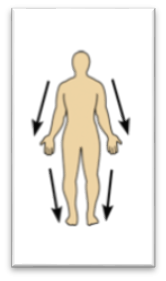
Name the Orientation and directional term.
- Distal
Farther from the origin of a body part - the knee is distal to the thigh.
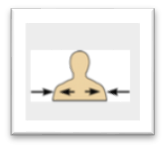
Name the Orientation and directional term.
- Superficial (external)
toward or at the body surface - the skin is superficial to the skeletal muscles.
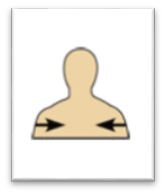
Name the Orientation and directional term.
- Deep (internal)
Away from the body surface; more internal - the lungs are deep to the skin
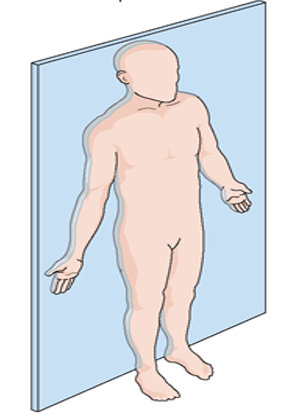
Name the plan in the picture.
- Frontal (coronal) plane
divide the body into anterior and posterior parts
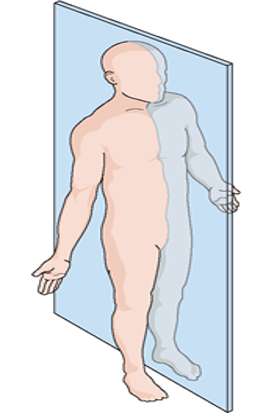
Name the plan in the picture.
- Median (midsagittal) Plane
A sagittal plane that lies EXACTLY in the midline
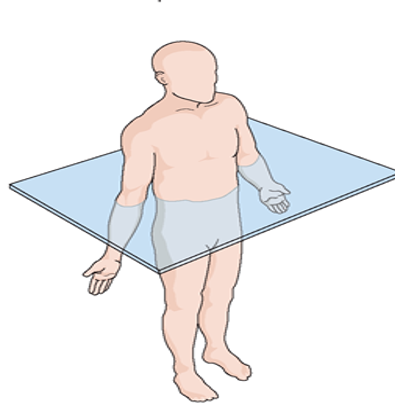
Name the plan in the picture.
- Transverse (horizontal) Plane
What plane consist of cuts made diagonally between the horizontal and the vertical planes
- Oblique sections
A vertical plane that divides the body into right and left sections is refereed to as what?
- Sagittal Plane
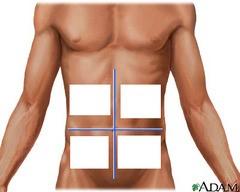
Name four abdominoplevic quadrants.
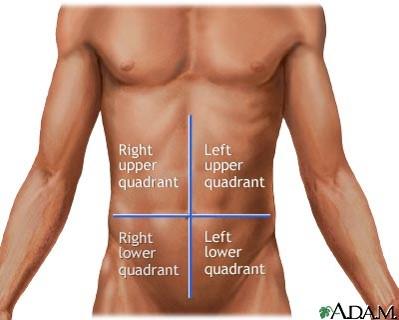
- Right upper
- Right lower
- Left upper
- Left lower
Name the 9 regions of the Ventral body cavity
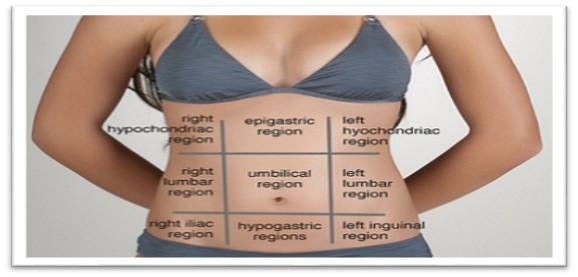
- Right hypochondriac region
- epigastic region
- Left hypochondriac region
- Right lumbar region
- Umbilical region
- Left lumbar region
- Right iliac (inguinal) region
- Hypogastiric (pubic) region
- Left iliac (inguinal) region
Name the 2 cavities located in the Dorsal body cavity.
- Cranial cavity (contains brain)
- Vertebral cavity (contains spinal cord)
Name the 2 major subdivisions of the Ventral body cavity.
- Thoracic cavity - surrounded by the ribs and muscle of the chest
- Abdominoplelvic cavity - inferior cavity seperated by the diaphragm
Which body cavity contains the heart and lungs?
- Thoracic
The liver is located in which adbominoplevic region?
- Right hypochondriac region
The gallbladder is locate in which adbominoplevic region?
- Right hypochondriac region
The ascending colon of the large intestine is locate in which adbominoplevic region?
- Right lumbar region
The appedix is locate in which adbominoplevic region?
- Right iliac (inguinal) region
The stomach is locate in which adbominoplevic region?
- Epigastic region
The transverse colon of large intestine is locate in which adbominoplevic region?
- Umbilical region
The urinary bladder is locate in which adbominoplevic region?
- Hypogastic (pubic) region
The diaphragm and sleen are locate in which adbominoplevic region?
- Left hypochondriac region
The descending colon of large intestine is locate in which adbominoplevic region?
- Left lumbar region
The initial part of sigmoid colon is locate in which adbominoplevic region?
- Left iliac (inguinal) region
Bones and cartilages are part of the ___________ system
- Skeletal system
The nasal cavity, lungs, and trachea are __________ system organs.
- Respiratory
_____________ is a term that encompasses all the chemical reaction that occur in the body cells.
- Metabolism